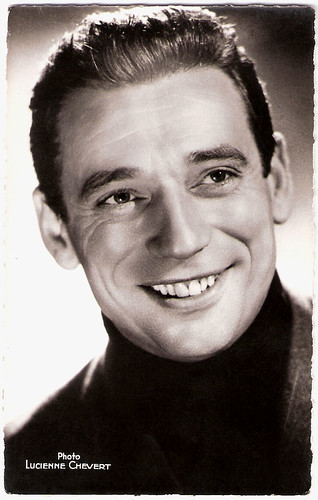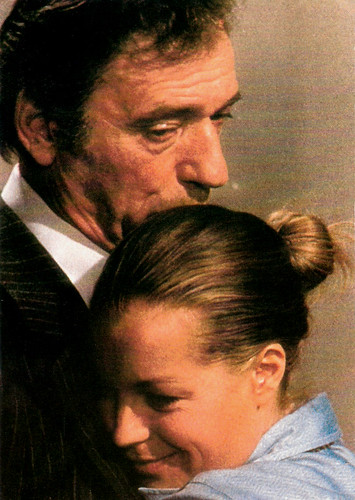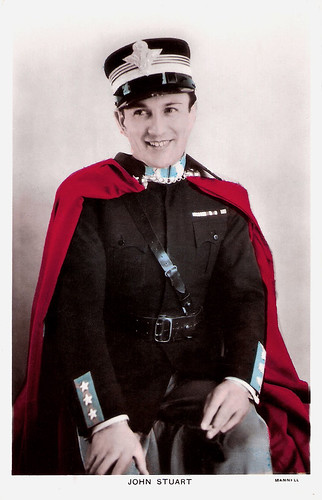There were a number of films produced in Europe and the US in 1938-1939 which tangibly transmitted the feeling of menacing madness that was about to unfold. Il Cinema Ritrovato (29 June - 6 July 2013) chose for its series War Is Near: 1938-1939 not so much those films most clearly foreshadowing the imminent conflict, as those that evoked an atmosphere of fears and fragile hopes, films made of subtle suggestion, shades and shadows and unspoken dialogue.
One of the screened films in Bologna is the Nazi propaganda film Pour le Mérite (Karl Ritter, 1938), which chronicles the rise of the Luftwaffe (German Air Force) from World War I until Adolf Hitler took power in 1933. Star is the German stage actor Paul Hartmann (1889-1977). During his long career, Hartmann made over 100 films, both in the silent and the sound period. Despite his commitment to the Nazi regime, he could continue his career quite smoothly into the 1950s and 1960s.
![Paul Hartmann]()
German postcard by Verlag Hermann Leiser, Berlin-Wilm., no. 9303. Photo: Zander & Labisch. Publicity still for Volk in Not/People in Need (Wolfgang Neff, 1925).
![Paul Hartmann]()
German postcard by Rotophot in the Film Sterne series, no. 161/2. Photo: Nicola Perscheid, Berlin.
![Paul Hartmann]()
German postcard by Rotophot in the Film Sterne series, no. 161/3. Photo: Nicola Perscheid, Berlin.
![Paul Hartmann]()
German postcard by Verl. Herm. Leiser, Berlin-Wilm., no. 3068. Photo: Atelier Oertel, Berlin.
Burgtheater
Paul Wilhelm Constantin Hartmann was born in Fürth, Germany in 1889. He was the son of Wilhelm Hartmann, the manager of a toy-export company, and his wife Maria Hartmann-Betz. From 1907 on, he studied acting with Adalbert Czokke, and in 1908 he had his first engagement at the Stadtheater Zwickau. In the following years he played at the Bellevue-Theater in Stettin, the Stadttheater Zürich, and from November 1913 at the Deutsche Theater in Berlin under direction of the legendary Max Reinhardt. He also started to work for the cinema. He made his film debut as a jeune premier in 1915 in Zofia - Kriegs-Irrfahrten eines Kindes/Zofia – the War Odysseys of a Child (Hubert Moest, 1915) with Ernst Pittschau and Hedda Vernon. Soon followed more films like Der Trick/The Trick (Fred Sauer, 1915) with Aud Egede Nissen, Die verschleierte Dame/The Veiled Lady (Richard Oswald, 1915), Ein Blatt Papier/A Page of Paper (Joe May, 1916), Feenhände/Hands of a Fairy (Rudolf Biebrach, 1916) with Henny Porten, the Harry Deebs detective Das Geheimnis der leeren Wasserflasche/The Secret of the Empty Water Bottle (Joe May, 1917) starring Harry Liedtke, Christa Hartungen (Rudolf Biebrach, 1917), and Es werde Licht!/Let There Be Light! (Richard Oswald, 1918). That same year, he appeared in Der Trompetter von Säkkingen/The Trumpeter of Säckingen (Franz Porten, 1918), based on a popular opera (1884) by Viktor Nessler, which in turn was based on a romantic book by Joseph Victor von Scheffel, published in 1854. The story is set in Heidelberg and Säckingen during the 17th century, after the Thirty Years War. Law student, later trumpeter Werner Kirchhof falls in love with Margareta, a baron's daughter, but her mother wants to marry her to the cowardly Damian. Werner proves to be a hero and a compassionate pope makes him marquis of Camposanto. Then, after five years of separation nothing can prevent a happy ending. Hartmann's stage and film career suffered a short break when he was called into the military service in 1917. After that he continued his film career smoothly. In the 1920s he played romantic and melancholic characters in films like Katharina die Grosse/Catherine the Great (Reinhold Schünzel, 1920) with Lucie Höflich, Anna Boleyn/Anne Boleyn (Ernst Lubitsch, 1920) with Emil Jannings and Henny Porten, Schloss Vogelöd/The Haunted Castle (Friedrich Wilhelm Murnau, 1921) with Olga Tschechova, Der Roman der Christine von Herre (Ludwig Berger, 1921) with Heinrich George, Luise Millerin (Carl Froelich, 1922) with Lil Dagover, Alt-Heidelberg/The Student Prince (Hans Behrendt, 1923) with Eva May, Zur Chronik von Grieshuus/The Chronicles of the Gray House (Arthur von Gerlach, 1925) and the silent film operetta Der Rosenkavalier/The Knight Of The Rose (Robert Wiene, 1925) with Jaque Catelain. In 1924 he worked at the Theater in der Josefstadt in Wien (Vienna), and in 1925 he moved over to the Burgtheater. From 1927 he turned away from the film business and devoted his career exclusively to the Burgtheater.
![Der Trompeter von Säkkingen]()
German postcard by Rotophot in the Series Film-Sterne, no. 534/5. Photo: Eiko-Film. Publicity still for Der Trompeter von Säkkingen (Franz Porten, 1918), starring Paul Hartmann. The outdoor scenes of the film were shot by Porten at Säckingen, using some 200 local extras.
![Der Trompeter von Säkkingen]()
German postcard by Rotophot in the Series Film-Sterne, no. 534/3. Photo: Eiko-Film. Publicity still for Der Trompeter von Säkkingen (Franz Porten, 1918), starring Paul Hartmann.
![Der Trompeter von Säkkingen]()
German postcard by Rotophot in the Series Film-Sterne, no. 535/5. Photo: Eiko-Film. Publicity still for Der Trompeter von Säkkingen (Franz Porten, 1918), starring Paul Hartmann.
![Paul Hartmann]()
German postcard by Verlag Hermann Leiser, Berlin, no. 3069. Photo: Atelier Oertel, Berlin.
Tough and Adamant Heroes
With the introduction of the sound film Paul Hartmann returned to the cinema. He played tough and adamant heroes, like the constructor and captain next to Hans Albers in the deluxe German/British production F.P.1 antwortet nicht/F.P.1 Doesn't Answer (Karl Hartl, 1932), or as the self sacrificing engineer in Der Tunnel/The Tunnel (Kurt aka Curtis Bernhardt, 1933). Other popular films were Der Läufer von Marathon/The Marathon Runner (Ewald André Dupont, 1933), Salon Dora Green/The House of Dora Green (Henrik Galeen, 1933) with Alfred Abel, and Mazurka (Willi Forst, 1935) with Pola Negri. From 1935 on he was a company member of the Preußischen Staatstheater in Berlin, where he stayed till the end of WW II. In 1934 he was named Staatsschauspieler (Stage Artist of the State), and from May 1937 he was part of the UFA Art Committee. He also appeared in such propaganda films as Pour le mérite (Karl Ritter, 1938), the biography Bismarck (Wolfgang Liebeneiner, 1940) and Ich klage an/I Accuse (Wolfgang Liebeneiner, 1941). In April 1942 he became the president of the Reichstheaterkammer. His commitment to the Nazi regime did not really harm his career or his popularity after the war. After being banned from the theatre in 1945 Hartmann could only return to the stage in 1948 as Faust in a production of the Goethe play in Bonn. During the 1950s he was engaged by the Schauspielhaus in Düsseldorf, the Theater am Kurfürstendamm in Berlin, and the Burgtheater in Vienna. He also returned to the cinema. The ageing star now mainly worked as a character actor in supporting roles, such as in Die Dame in Schwarz/The Lady in Black (Erich Engels, 1951) with Mady Rahl, Der grosse Zapfenstreich/The Sergeant's Daughter (George Hurdalek, 1953) with Johanna Matz, Regina Amstetten (Kurt Neumann, 1954), Die Barrings/The Barrings (Rolf Thiele, 1955) with Dieter Borsche and Nadja Tiller, Der Fuchs von Paris/The Fox of Paris (Paul May, 1957), Buddenbrooks (Alfred Weidenmann, 1959), and Rosen für den Staatsanwalt/Roses for the Prosecutor (Wolfgang Staudte, 1959). He finished his film career in the 1960s with productions like the TV-film Hermann und Dorothea (Ludwig Berger, 1961), the Heimatfilm Waldrausch (Paul May, 1962), and the international war film The Longest Day (Ken Annakin, Andrew Marton, Bernhard Wicki, 1962), an all-star re-creation of the D-Day invasion, personally orchestrated by Darryl F. Zanuck. Hartmanns last appearance was in the TV-film Demetrius (Ludwig Berger, Heribert Wenk, 1969). In 1964 he was awarded the Filmband in Gold for his continuing and outstanding contributions to the German Film. Paul Hartmann died in 1977 in München (Munich). He was married twice. During WWI he had married a Slavic ballet dancer, who died in 1952. In 1955 he married the painter Elfriede Lieberun.
![Paul Hartmann]()
German postcard by Verlag Hermann Leiser, Berlin, no. 8766. Photo: Becker & Maass.
![Paul Hartmann]()
Austrian postcard by Iris Verlag, no. 689. Photo: Hugo Engel Filmproduktion. Publicity still for Die Familie ohne Moral/The family with no morals (Max Neufeld, 1927).
![Paul Hartmann, Jedermann]()
German postcard by Cozy Verlag, Salzburg. Photo: Friedrich Franz Bauer. Publicity still for the stage production Jedermann, performed at the Salzburger Festspiele.
![Paul Hartmann]()
German postcard by Ross Verlag, no. A 3255/1, 1941-1944. Photo: Tobis / Foto Dähn.
![Paul Hartmann]()
German postcard by Das Programm von Heute, Berlin. Photo: Tobis / Klagemann.
Sources: Thomas Staedeli (Cyranos), Hal Erickson (AllMovie), Wikipedia (German), and IMDb.
One of the screened films in Bologna is the Nazi propaganda film Pour le Mérite (Karl Ritter, 1938), which chronicles the rise of the Luftwaffe (German Air Force) from World War I until Adolf Hitler took power in 1933. Star is the German stage actor Paul Hartmann (1889-1977). During his long career, Hartmann made over 100 films, both in the silent and the sound period. Despite his commitment to the Nazi regime, he could continue his career quite smoothly into the 1950s and 1960s.

German postcard by Verlag Hermann Leiser, Berlin-Wilm., no. 9303. Photo: Zander & Labisch. Publicity still for Volk in Not/People in Need (Wolfgang Neff, 1925).

German postcard by Rotophot in the Film Sterne series, no. 161/2. Photo: Nicola Perscheid, Berlin.

German postcard by Rotophot in the Film Sterne series, no. 161/3. Photo: Nicola Perscheid, Berlin.

German postcard by Verl. Herm. Leiser, Berlin-Wilm., no. 3068. Photo: Atelier Oertel, Berlin.
Burgtheater
Paul Wilhelm Constantin Hartmann was born in Fürth, Germany in 1889. He was the son of Wilhelm Hartmann, the manager of a toy-export company, and his wife Maria Hartmann-Betz. From 1907 on, he studied acting with Adalbert Czokke, and in 1908 he had his first engagement at the Stadtheater Zwickau. In the following years he played at the Bellevue-Theater in Stettin, the Stadttheater Zürich, and from November 1913 at the Deutsche Theater in Berlin under direction of the legendary Max Reinhardt. He also started to work for the cinema. He made his film debut as a jeune premier in 1915 in Zofia - Kriegs-Irrfahrten eines Kindes/Zofia – the War Odysseys of a Child (Hubert Moest, 1915) with Ernst Pittschau and Hedda Vernon. Soon followed more films like Der Trick/The Trick (Fred Sauer, 1915) with Aud Egede Nissen, Die verschleierte Dame/The Veiled Lady (Richard Oswald, 1915), Ein Blatt Papier/A Page of Paper (Joe May, 1916), Feenhände/Hands of a Fairy (Rudolf Biebrach, 1916) with Henny Porten, the Harry Deebs detective Das Geheimnis der leeren Wasserflasche/The Secret of the Empty Water Bottle (Joe May, 1917) starring Harry Liedtke, Christa Hartungen (Rudolf Biebrach, 1917), and Es werde Licht!/Let There Be Light! (Richard Oswald, 1918). That same year, he appeared in Der Trompetter von Säkkingen/The Trumpeter of Säckingen (Franz Porten, 1918), based on a popular opera (1884) by Viktor Nessler, which in turn was based on a romantic book by Joseph Victor von Scheffel, published in 1854. The story is set in Heidelberg and Säckingen during the 17th century, after the Thirty Years War. Law student, later trumpeter Werner Kirchhof falls in love with Margareta, a baron's daughter, but her mother wants to marry her to the cowardly Damian. Werner proves to be a hero and a compassionate pope makes him marquis of Camposanto. Then, after five years of separation nothing can prevent a happy ending. Hartmann's stage and film career suffered a short break when he was called into the military service in 1917. After that he continued his film career smoothly. In the 1920s he played romantic and melancholic characters in films like Katharina die Grosse/Catherine the Great (Reinhold Schünzel, 1920) with Lucie Höflich, Anna Boleyn/Anne Boleyn (Ernst Lubitsch, 1920) with Emil Jannings and Henny Porten, Schloss Vogelöd/The Haunted Castle (Friedrich Wilhelm Murnau, 1921) with Olga Tschechova, Der Roman der Christine von Herre (Ludwig Berger, 1921) with Heinrich George, Luise Millerin (Carl Froelich, 1922) with Lil Dagover, Alt-Heidelberg/The Student Prince (Hans Behrendt, 1923) with Eva May, Zur Chronik von Grieshuus/The Chronicles of the Gray House (Arthur von Gerlach, 1925) and the silent film operetta Der Rosenkavalier/The Knight Of The Rose (Robert Wiene, 1925) with Jaque Catelain. In 1924 he worked at the Theater in der Josefstadt in Wien (Vienna), and in 1925 he moved over to the Burgtheater. From 1927 he turned away from the film business and devoted his career exclusively to the Burgtheater.

German postcard by Rotophot in the Series Film-Sterne, no. 534/5. Photo: Eiko-Film. Publicity still for Der Trompeter von Säkkingen (Franz Porten, 1918), starring Paul Hartmann. The outdoor scenes of the film were shot by Porten at Säckingen, using some 200 local extras.

German postcard by Rotophot in the Series Film-Sterne, no. 534/3. Photo: Eiko-Film. Publicity still for Der Trompeter von Säkkingen (Franz Porten, 1918), starring Paul Hartmann.

German postcard by Rotophot in the Series Film-Sterne, no. 535/5. Photo: Eiko-Film. Publicity still for Der Trompeter von Säkkingen (Franz Porten, 1918), starring Paul Hartmann.

German postcard by Verlag Hermann Leiser, Berlin, no. 3069. Photo: Atelier Oertel, Berlin.
Tough and Adamant Heroes
With the introduction of the sound film Paul Hartmann returned to the cinema. He played tough and adamant heroes, like the constructor and captain next to Hans Albers in the deluxe German/British production F.P.1 antwortet nicht/F.P.1 Doesn't Answer (Karl Hartl, 1932), or as the self sacrificing engineer in Der Tunnel/The Tunnel (Kurt aka Curtis Bernhardt, 1933). Other popular films were Der Läufer von Marathon/The Marathon Runner (Ewald André Dupont, 1933), Salon Dora Green/The House of Dora Green (Henrik Galeen, 1933) with Alfred Abel, and Mazurka (Willi Forst, 1935) with Pola Negri. From 1935 on he was a company member of the Preußischen Staatstheater in Berlin, where he stayed till the end of WW II. In 1934 he was named Staatsschauspieler (Stage Artist of the State), and from May 1937 he was part of the UFA Art Committee. He also appeared in such propaganda films as Pour le mérite (Karl Ritter, 1938), the biography Bismarck (Wolfgang Liebeneiner, 1940) and Ich klage an/I Accuse (Wolfgang Liebeneiner, 1941). In April 1942 he became the president of the Reichstheaterkammer. His commitment to the Nazi regime did not really harm his career or his popularity after the war. After being banned from the theatre in 1945 Hartmann could only return to the stage in 1948 as Faust in a production of the Goethe play in Bonn. During the 1950s he was engaged by the Schauspielhaus in Düsseldorf, the Theater am Kurfürstendamm in Berlin, and the Burgtheater in Vienna. He also returned to the cinema. The ageing star now mainly worked as a character actor in supporting roles, such as in Die Dame in Schwarz/The Lady in Black (Erich Engels, 1951) with Mady Rahl, Der grosse Zapfenstreich/The Sergeant's Daughter (George Hurdalek, 1953) with Johanna Matz, Regina Amstetten (Kurt Neumann, 1954), Die Barrings/The Barrings (Rolf Thiele, 1955) with Dieter Borsche and Nadja Tiller, Der Fuchs von Paris/The Fox of Paris (Paul May, 1957), Buddenbrooks (Alfred Weidenmann, 1959), and Rosen für den Staatsanwalt/Roses for the Prosecutor (Wolfgang Staudte, 1959). He finished his film career in the 1960s with productions like the TV-film Hermann und Dorothea (Ludwig Berger, 1961), the Heimatfilm Waldrausch (Paul May, 1962), and the international war film The Longest Day (Ken Annakin, Andrew Marton, Bernhard Wicki, 1962), an all-star re-creation of the D-Day invasion, personally orchestrated by Darryl F. Zanuck. Hartmanns last appearance was in the TV-film Demetrius (Ludwig Berger, Heribert Wenk, 1969). In 1964 he was awarded the Filmband in Gold for his continuing and outstanding contributions to the German Film. Paul Hartmann died in 1977 in München (Munich). He was married twice. During WWI he had married a Slavic ballet dancer, who died in 1952. In 1955 he married the painter Elfriede Lieberun.

German postcard by Verlag Hermann Leiser, Berlin, no. 8766. Photo: Becker & Maass.

Austrian postcard by Iris Verlag, no. 689. Photo: Hugo Engel Filmproduktion. Publicity still for Die Familie ohne Moral/The family with no morals (Max Neufeld, 1927).

German postcard by Cozy Verlag, Salzburg. Photo: Friedrich Franz Bauer. Publicity still for the stage production Jedermann, performed at the Salzburger Festspiele.

German postcard by Ross Verlag, no. A 3255/1, 1941-1944. Photo: Tobis / Foto Dähn.

German postcard by Das Programm von Heute, Berlin. Photo: Tobis / Klagemann.
Sources: Thomas Staedeli (Cyranos), Hal Erickson (AllMovie), Wikipedia (German), and IMDb.













































































































































































